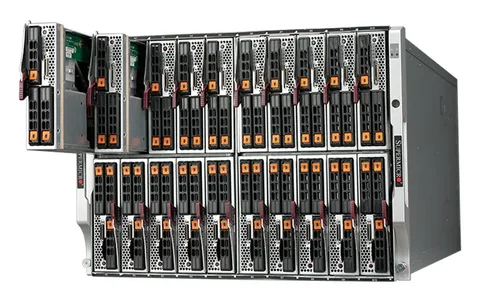As businesses continue to rely heavily on data centers to store, process, and manage their digital assets, the demand for efficient and scalable server architectures has never been greater. One of the most popular and effective options for data center servers is the blade server, a compact and modular design that combines high performance, flexibility, and cost-effectiveness. In this article, we will explore the key features, benefits, and challenges of blade servers, and discuss how they can help organizations optimize their IT infrastructure.
Blade Servers - A Modular and Space-Saving Design
Blade servers are designed to be slim, interchangeable units that can be easily inserted and removed from a chassis or enclosure. Each blade typically includes one or more processors, memory modules, storage devices, networking interfaces, and management modules, as well as power and cooling components. The blades are connected to a backplane, which provides high-speed communication between the blades and the external network.
One of the key advantages of blade servers is their space-saving design. By consolidating multiple blades in a single chassis, data centers can reduce their footprint and increase their density, while still maintaining high performance and availability. Blade servers also offer better power efficiency than traditional rack-mounted servers, as they can share power and cooling resources more effectively. Moreover, blade servers allow for easy scaling and upgrading, as new blades can be added or replaced without having to change the entire infrastructure.
The Benefits of Blade Servers for Data Centers
Blade servers offer several benefits for data centers of all sizes and industries. Here are some of the most significant advantages:
-
High performance: Blade servers are built to deliver exceptional computing power and speed, thanks to their high-density design, multi-core processors, and fast memory and storage options. They are particularly well-suited for virtualization and cloud computing workloads, as they can handle multiple virtual machines and applications simultaneously.
-
Flexibility: Blade servers allow data centers to customize their infrastructure to meet their specific needs, by choosing the right mix of blades, networking options, and management tools. They can also support different operating systems, hypervisors, and applications, providing a versatile platform for diverse workloads.
-
Easy management: Blade servers come with built-in management tools that allow administrators to monitor and control the blades and the entire infrastructure from a single console. This simplifies tasks such as provisioning, configuration, patching, and troubleshooting, reducing the time and effort required to maintain the servers.
-
Cost savings: Blade servers can help data centers save money in several ways. By reducing the physical space and power consumption, they can lower the facility and energy costs. By providing a scalable and flexible architecture, they can avoid the need for expensive hardware upgrades or replacements. And by increasing the utilization and availability of the servers, they can boost the productivity and revenue of the organization.
The Challenges of Blade Servers and How to Address Them
While blade servers offer many benefits, they also pose some challenges that need to be addressed to ensure their optimal performance and security. Here are some of the most common challenges and solutions:
-
Complexity: Blade servers can be complex to configure, manage, and troubleshoot, especially when dealing with multiple blades, networking interfaces, and management tools. To address this challenge, data centers should invest in training, automation, and monitoring tools that can simplify the operations and reduce human errors.
-
Heat and power: Blade servers can generate a lot of heat and consume a lot of power, especially when fully loaded or under heavy workload. To address this challenge, data centers should optimize their cooling and power distribution systems, by using efficient cooling solutions, hot-aisle/cold-aisle containment, and power management software.


No comments yet